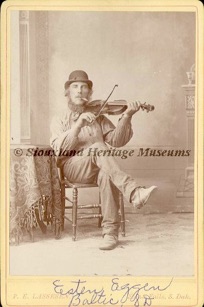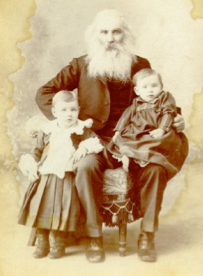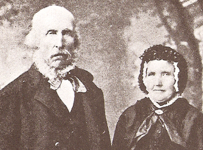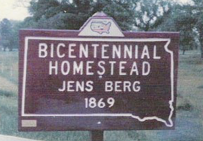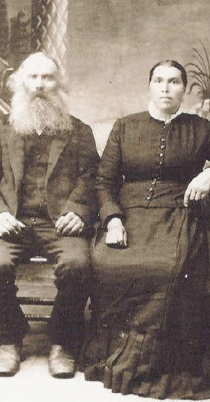Photo from the Meråker Historical Society
Sivert Berg clock. You can read: “ Sivert Berg Meraker” on the face of the clock. According to the Stjørdalsboka, Sivert’s father was a watchmaker. The Meråker Historical Society recently bought this clock and will place it on display in the museum in Pulden. Here’s a link to the article. LINK New article. LINK
••••••••••••••••••••••••••••••••••••••••••••
Very cool fact
How long has this family been in Sioux Falls?
According to the book “Pioneer History” it was a very specific date. July 26, 1869.
••••••••••••••••••••••••••••••••••••••••••••
New Pages
I’ve been adding new pages that are not included in the navigation menu at the top of the page. If you are interested in this part of the family here’s the links.
• Esten’s Death in a Blizzard 1873
New page July 2013
• Jens Berg Probate
Link will take you to FamilySearch website.
• Minnehaha County, Probate Records 1873-1935
Link will take you to FamilySearch website. Incredibly useful.
••••••••••••••••••••••••••••••••••••••••••••
NOTE
I’ve moved to a new domain. Most of the links will not work. It will be slow, but I am working on fixing the links as I make new pages.
••••••••••••••••••••••••••••••••••••••••••••••••••••
More Clock Photos
Thanks to Trudy Dekeuster for these photos of the Sivert Berg Clock! She traveled to Norway this past June and was able to visit Meraker and see the clock. This is not where the clock will live. It’s only temporary while they find a good spot for it. Now they are attempting to discover who the clock was originally made for.
View 1 LINK • View 1 LINK • View 1 LINK
••••••••••••••••••••••••••••••••••••••••••••••••••••
Sivert and Guro Berg
Sivert Sivertsen Berget was born March 3, 1823 in
Øvre Størdalen (now Meråker), Norway. His Wife Guro Eystensdatter was born in 1835 in Lilleelvdalen (now Alvdal), Norway. Here’s a great series of maps that help show how the area changed from 1837 to the present. LINK
They were married on June 20, 1861.
Permanent pagelink: LINK Permanent imagelink: LINK
The name Berg is a shortened version of Berget and comes from Norwegian naming practices at the time.
Here’s the 1801 Census showing Sivert’s Father & Grandfather living on the Berget Farm. LINK
In 1865 they lived on the Berget farm in Meråker, Norway. There were 8 people in their household. Sivert (age 43), his wife Guru (age 31), his son Sivert (age 5) and his daughter Maria (age 2). Sivert’s occupation is listed as Saugmester (Master Sawmiller). They had 4 cattle, 4 sheep and also farmed mixed grain and potatoes.
LINK to 1865 census.
The crop references in the census - ie: Mixed grain 1/2 and Potatoes 4 - are not showing acreage. These numbers are referring to the yield by ton. If you're interested, here's a link to a more detailed discussion of the measurements. LINK
Also living with them are his father Sivert (age 66) who is retired and a widower. His two daughters Mali (age 26) and Berit (age 40). Her son Anton Johansen (age 13) is also living with them. Berit is listed as being Mentally Ill.
••••••••••••••••••••••••••••••••••••••••••••••••••••
Berit’s Epilepsy
There's only 4 entries you could make under illness.
b = blind = blind
d = døv/døvstum = deaf/deafmute
s = sinnssyk/sinnssvak = mentally ill
a = åndssvak = mentally retarded
Under Illness, Berit is marked “s”. We know from the book “Pioneer History” that... "She died of a falling disease (Folde Syge) being found of brother Jens, lying over a chest." Epilepsy was known as the falling disease and I believe it was viewed as a mental disease in the 19th century. Berit was an unwed mother. Anton was her only son. After her death, he moved to the west coast. When he came back to visit, he was stricken with heart attack and died at his Uncle's place. (Jens). He’s buried in Berg Cemetery.
Anton J. Aspaas died 11/12/1887.

Anton Berg’s Steamer Trunk
"Anton J Berg • Sioux City, Iowa, North Amerika • via Milwaukee"
••••••••••••••••••••••••••••••••••••••••••••••••••••
What Happened To Sivert’s Father?
From "Heim og Slekt - Brukere 1865" (Home and Family Users 1865) Next owners of Berget farm in 1865. When they emigrated in 1867 sister Mali Sivertsdatter Berget and husband Ole Pedersen Trøbakk took over the farm and took care of Mali's father, Sivert Sivertsen until his death in 1870. They emigrated in 1875 and the farm was sold to Ingebrigt Jonassen Strigsve.
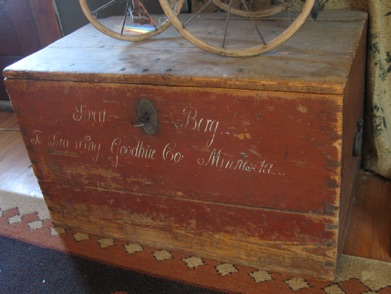
Sivert Berg’s Steamer Trunk
"Sivert Berg • To Redwing, Goodhue Co., Minnesota"
1867 Emigration To America
On May 2, 1867 the Bergs immigrated to America. They left Trondheim, Norway on the ship “Neptunus” bound for Quebec, Canada and arrived on June 19th.
Here’s a painting of the Neptunus. LINK
It belongs to the Sverresborg Trøndelag Folkemuseum. LINK
Here’s a link to the passenger list with Sivert and Guru Berg. The passengers on this ship were the first persons to be listed in the Trondheim police emigration protocols.
From Quebec, they most likely took another ship to Milwaukee and moved to Goodhue County, Minnesota. Sivert’s brother Jens, his sister Berit and her son Anton also immigrated and lived nearby. Jens and his family left Trondheim May 16, 1865 on the ship “Bergen”. LINK
They only lived there for a couple of years and must have decided that it was still too crowded. They picked up and moved to Minnehaha County in the Dakota Territory. According to the book “Pioneer History” it was a specific date. July 26, 1869. They homesteaded the west tier of forties in section 29 in Mapleton township. 1867 Emigration
Why did they decide to leave Norway? There’s quite a few reasons.
“Between 1825 and 1925, more than 800,000 Norwegians immigrated to America—about one-third of Norway's population. With the exception of Ireland, no single country contributed a larger percentage of its population to America than Norway.”
(Source: Norway’s Official Website)
There’s a good article here:
Why They Left and Why They Came
Probably the biggest reason was LAND. It was in short supply in Norway at the time. If it was available at all it was very expensive. The Homestead Act was signed into law on May 20, 1862 by President Abraham Lincoln. It promised freehold title of up to 160 acres (1/4 section) of undeveloped land and only required three simple steps:
1) file an application
2) improve the land
3) file for deed of title
••••••••••••••••••••••••••••••••••••••••••••••••••••
Homestead Records
When the Bergs finally reached Sioux Falls we can see that they each acquired 160 acres - and more. The original Homestead Records are below, but here are the 1903 records.
1903 LANDOWNERS: LINK
Berg, Sivert • Mapleton • Section 29 • 160 acres
Berg, Severt • Mapleton • Section 30 • 40 acres
Berg, J. S. • Mapleton • Section 30 • 160 acres
Berg, J. S. • Mapleton • Section 32 • 40 acres
Berg, J. S. • Mapleton • Section 32 • 120 acres
Image of Sivert Berg Land Patent for 160 acres
issued August 8, 1878. LINK
Image of Sivert Berg Land Patent for 40 acres
issued June 25, 1890. LINK
Land Patent Case Files of Sivert Berg
Use the “Homestead Files” link at the top of the page to see them.
••••••••••••••••••••••••••••••••••••••••••••••••••••
"History of Minnehaha County"
You can read through a lot of stories about the Pioneers online. "History of Minnehaha County" by Dana R. Bailey is a very interesting read.
There are biography entries for both Jens and Sivert.
WHO ARE THESE PEOPLE?
You’ll see a long list of names in the text below but don’t miss the big picture. He’s describing a large group of people and the amazing journey they made. He misses quite a few names, which is to be expected, but he makes sure that the stories the entire group talked about are here.
Sivert Kringen came with Sivert Berg. He's on the “Neptunus” list directly above Sivert Berg. On the long voyage over I’m sure they discussed their future plans. When they got to Goodhue County and realized that most of the good land was already claimed, they must have thought “I didn’t come all this way to work on another man’s land. I could have stayed in Norway to do that.” They decided to keep moving and sent a few members of the group out west to find a good place to make their claim.
Here’s a few of the names from the excerpt below that were onboard the Neptunus with Sivert. I’m sure there’s even more.
Sivert Eriksen Kringen* 26 m Son - Residence Stjørdalen*
Peder Paulsen 21 m Residence Meraager*
Paul Andersen Risvold 54 m Residence Meraager*
Gulmund Olsen Dalemoe 33 m Residence Stjørdalen
Six Langnæss were on the ship as well.
Gullik E. Kringen was 19 when he left on the Ship Victor in 1866, from Trondheim Apr. 25 to Quebec June 9, 1866.
With all this in mind, here’s a link to the book online and an excerpt:
In the spring of 1868, John 0. Langness and Sivert and Gullick Kringen started west, from Minnesota, to find a place suitable to organize a colony. They found no place that suited them so well as the Sioux Valley, and returning to Minnesota they came back in the fall, bringing with them a large number of Scandinavians, among whom were the following: Gudmund T. Ravlo and his sons, who are still living in the county; Nils Iverson, Iver and Nils Nilson, Rollof Pederson, J. Krogstad, Lars Kvarnmo, Jens Berg, Peder and Thomas Paulson.; Paul A Risvold and his two sons, Andrew and Peder Risvold; Gudmund Dalemo, Ole Thompson, Guttorm Eklo and his son Peter Magnus; John Bruaas, who settled at Baltic; Halvor Nyhus, Thorsten and Jonas Nassan and Ole Hougtro. 0. B. Iverson and Ole Bergerson settled in Split Rock, and John Walker also settled there about this time.
John Langness brought with him a whim saw, which was in constant demand in constructing the houses the settlers began to build. Ole Thompson and Mr. Langness would saw two hundred feet of boards with this saw in a day, John Thompson sent to the "old country'' for one of these saws, and afterwards procured another nearer home, and there were two or three others in use in this vicinity. This method of manufacturing lumber by the early settlers affords a striking illustration of the limited advantages and resources of pioneer days. John Anderson Ole and Gunder Thompson settled about two males from the present city of Dell Rapids. Ole Thompson used to help the Indians break their lands, and as his plow accomplished the purpose far better and in much shorter time than their implements, they rave him the name of "Maka-jubbedu-tanka" or "The great landbreaker."
••••••••••••••••••••••••••••••••••••••••••••••••••••
The Bergs in “Pioneer History”
Pioneer history: Minnehaha County's Norwegian pioneers: history from the year 1866 to 1896.
1976 gathered and published by Minnehaha County's Norwegian Pioneer Organization; editors, Iver I. Oien ... [etal.]; translated and reprinted 1976 by Emily Brende Sittig and Clara Brende Christenson.
Emily Brende Sittig was Leona’s teacher for three years at the Eggers School one room schoolhouse. There are photos of it in the Erickson link. Leona had this book and must have used it as a reference for her Erickson Family History.
“Emily Brende Sittig was my favorite teacher because she was my first for three years.” -Leona
Thanks to George Carlson for these images.
Jens and Ellen Berg, Sivert and Guro Berg NEW in English
Jens and Ellen Berg, Sivert and Guro Berg OLD in Norwegian
Jens and Ellen Berg, Sivert and Guro Berg OLD in Norwegian

Sivert the Toastmaster
The first couple to have a Golden Wedding Anniversary in Minnehaha county was Paul and Ingeborg Kvermo. A grand celebration was held and Sivert Berg served as the Toastmaster. The quote pictured above is the original Norwegian text.
English version. LINK
Norwegian version. LINK
Paul and Ingeborg Kvermo
They are buried in Pioneer Cemetery under that spelling.
Different names here: Passenger list 1866 - bark Nicanor
Departure: Trondheim May 25 • Arrival: Quebec July 10, 1866
Paul Thomassen Kværnmoe Age 54
Ingeborg Didersdatter Kværnmoe* Age 60
(Marriage record shows Ingeborg Pedersdatter. Her father is Peder Olsen)
Paul and Ingeborg Kvermo Marriage record. November 18, 1832.
Source: Nord-Trøndelag fylke, Stjørdal, Ministerialbok nr. 709A10 (1820-1832), Ekteviede 1832, page 389.
Permanent page link: LINK
Permanent image link: LINK
••••••••••••••••••••••••••••••••••••••••••••••••••••
Guru’s Brother and Parents
Sivert’s wife was Guro Eystensdatter. Her sister Ellen Estensdatter Volden was married to Sivert’s brother Jens. Her parents and brother made the trip to America as well. Guru’s mother died in Goodhue county, Minnesota. Her brother Esten Eggen and Sivert’s brother Jens Berg made the trip back to Goodhue to bring Esten Volden back.
Here’s a link to Eysten Johnsen and wife Kari in Meråker on the farm: Volden Søndre.
Esten is buried in Berg Cemetery as Esten Jonson. He froze to death in a blizzard on 7 Jan 1873. Esten Eggen and his wife are there as well.
••••••••••••••••••••••••••••••••••••••••••••••••••••
Inspection Record of The “Neptunus”
From Norway Heritage Site
In 1867 she departed from Trondheim May 2nd, and arrived at Quebec June 19th. The ship was inspected before leaving Trondheim, and was found to be in perfect order. It had sufficient supplies of water, food and medicine. On this voyage the Neptunus carried 347 passengers, 124 adult men, 111 adult women, 97 children between the age of 1 -14 and 15 children under 1 year. Most of the passengers were from Selbu, Aalen, Holtaalen. The passengers on this ship were the first persons to be listed in the Trondheim police emigration protocols. The ship had a crew of 17 included the Captain.
••••••••••••••••••••••••••••••••••••••••••••••••••••
Karen Berg’s Birth Record
••••••••••••••••••••••••••••••••••••••••••••••••••••
How long did an immigrant have to work to pay for their trip over?
From “The Old Church” A short history of Nidaros Congregation from it’s founding in the year 1868. By H.A. Ustrud • Published May, 1926 • Preface of book LINK
NOTE: A lot of “Newcomers” from Norway were arriving and needed to pay for their journey over. Here’s an excerpt from “The Old Church” that talks about how long they needed to work to pay for the journey.
Most of the Newcomers were young people, who went into service among their fellow parishers ... several newcomer girls and boys were put to work. Many of these worked to pay for their trip over. The prevalent contract was one year for the boys and a little longer for the girls. That was because Uncle Sam passed a law which forbid contract labor. Not all were satisfied with the law, and that time was later often spoken of, as the slave-time. But, when all is taken into consideration, their situation wasn't the worst. They went to a school, entered into affairs here in America, and worked themselves forward so that many of them became the most respected people in the country.
••••••••••••••••••••••••••••••••••••••••••••••••••••
Berg One Room Schoolhouse
District 17 was formed April 4, 1876 and a one room school house was built on Jens Berg’s land. Elections were also held there. Jens Berg died December 27, 1902. Three years later his widow Ellen and their daughter Maria Jensdatter Berg Schjodt donated 1/2 acre to the county. All of the Ericksons attended school there until it closed in 1957. Karen Berg’s daughter Gertrude ERICKSON Lofgren became a grade school teacher. A new grade school was built northwest of the location in Renner. The names Renner and Berg were combined for the new RenBerg School.
There is a new book out that some may be interested in.
“Rural Schools of Minnehaha County 1871-1971”, by Celia Benson. LINK
Ole and Dorthea Floren marriage at the Berg farm 1886 ••••••••••••••••••••••••••••••••••••••••••••••
Marriage Records Book 1 Minnehaha
Groom: Floren, Ole Larsen
Bride: Nilsdatter, Dorthea
Date: June 19, 1886
Married By: O.O. Sando (photos of him above)
Title: Pastor Lutheran Church
Location: Sivert Berg Home / Mapleton
Witnesses: John Thompsen, Sivert Berg
Page#: 357
Ole and Dorthea Floren in “Pioneer History”
••••••••••••••••••••••••••••••••••••••••••••••••••••
Rootsweb link with the Bergs
A lot of good information in here thanks to Trudy Dekeuster and Julie Sjoberg.






